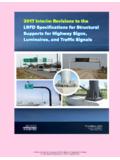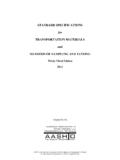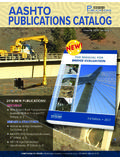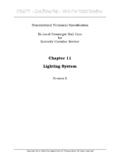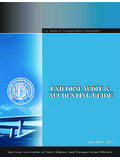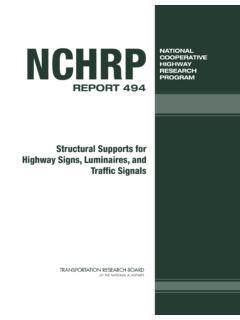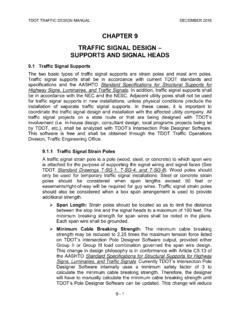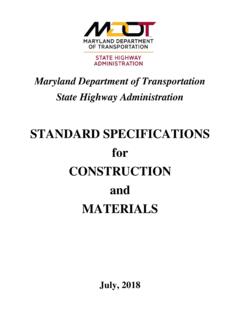Transcription of © 2016 by the American Association of State Highway and ...
1 2016 by the American Association of State Highway and Transportation rights reserved. Duplication is a violation of applicable : 978-1-56051-655-2 Pub Code: LRFDLTS-1-I1-OL American Association of State Highway and Transportation Officials 444 North Capitol Street, NW, Suite 249 Washington, DC 20001 202-624-5800 phone/202-624-5806 fax 2016 by the American Association of State Highway and Transportation Officials. All rights reserved. Duplication is a violation of applicable law. 2016 by the American Association of State Highway and Transportation rights reserved. Duplication is a violation of applicable INTERIM REVISIONS TO THE LRFD structural SUPPORTS INSTRUCTIONS AND INFORMATION FOR Highway SIGNS, LUMINAIRES, AND TRAFFIC SIGNALS iii 2017 INTERIM REVISIONS INSTRUCTIONS AND INFORMATION General AASHTO has issued interim revisions to the LRFD structural Supports for Highway Signs, Luminaires, and Traffic Signals, First Edition (2015).
2 This packet contains the revised pages. They are designed to replace the corresponding pages in the book. Affected Articles Underlined text indicates revisions that were approved in 2016 b y the AASHTO Highways Subcommittee on Bridges and Structures. Strikethrough text indicates any deletions t hat were likewise approved by the Subcommittee. A list of affected articles is included below. All interim pages are displayed on a pink background to make the changes stand out when inserted in the first edition binder. They also have a page header d isplaying the section number affected and the interim publication year. Please note that these pages may also contain nontechnical ( , editorial) changes made by AASHTO publications staff; any changes of this type will not be marked in any way so as not to distract the reader from the technical changes. 2017 C hang ed Articles SECTION 3: LOADS SECTION 5: STEEL DESIGN SECTION 10: SERVICEABILITY REQUIREMENTS SECTION 11: FATIGUE DESIGN SECTION 12: BREAKAWAY SUPPORTS APPENDIX B: DESIGN AIDS 2016 by the American Association of State Highway and Transportation rights reserved.
3 Duplication is a violation of applicable INTERIM REVISIONS TO THE LRFD structural SUPPORTS INSTRUCTIONS AND INFORMATION FOR Highway SIGNS, LUMINAIRES, AND TRAFFIC SIGNALS ivTHIS PAGE LEFT BLANK INTENTIONALLY 2016 by the American Association of State Highway and Transportation rights reserved. Duplication is a violation of applicable INTERIM REVISIONS TO THE LRFD structural SUPPORTS FOR Highway SIGNS, LUMINAIRES, AND TRAFFIC SIGNALS SECTION 3: LOADS Gust Effect Factor G The gust effect factor, G, shall be taken as a minimum of G is the gust effect factor and it adjusts the effective velocity pressure for the dynamic interaction of the structure with the gust of the wind. Information presented in ASCE/SEI 7-10 states that if the fundamental frequency of a structure is less than one Hz or if the ratio of the height to least horizontal dimension is greater than 4, the structure should be designed as a wind-sensitive structure.
4 Thus, virtually all structures addressed by these Specifications should be classified as wind-sensitive structures based on the height to least horizontal dimension ratio. It is not appropriate to use a nonwind-sensitive gust effect factor, G, for the design of sign , luminaire , and traffic signal structures. Special procedures are presented in the commentary of ASCE/SEI 7 for the calculation of the gust effect factor for wind-sensitive structures. The ASCE/SEI 7 calculation procedure requires reasonable estimates of critical factors such as the damping ratio and fundamental frequency of the structure. These factors are site and structure dependent. Relatively small errors in the estimation of these factors result in significant variations in the calculated gust effect factor. Therefore, even though sign , luminaire , and traffic signal support structures are wind sensitive, the benefits of using the ASCE/SEI 7 gust effect factor calculation procedure do not outweigh the complexities introduced by its use.
5 If the designer wishes to perform a more rigorous gust effect analysis, the procedures presented in ASCE/SEI 7 may be used with permission of the Owner. Drag Coefficients Cd The wind drag coefficient, Cd, shall be determined from Table Cv shall be taken as: Cv = for the Extreme Limit State Cv = otherwise The wind drag coefficients in Table were established based upon the work of several research projects as noted in the footnotes. Some coefficients are a strong function of Reynold s number. The term CvVd is a simplified form of Reynolds using units convenient for LTS design. The algebraic form of these equations is somewhat different ; however, the behavior is similar as illustrated in Figure and and where different shapes and equations are shown. The typical extreme event wind speed is 105 mph or greater. Therefore, for diameters 8-in. or greater, the Cd is associated with the turbulent case, CvVd > 78 mph-ft, and the Cd is a constant (rightmost column of Table ).
6 For smaller members, ASCE/SEI 07-10 wind speeds will tend to lower the Cd term compared to past practice. The Cv term at the extreme limit State adjusts the wind speed to correspond to past drag coefficients used for elements subject to wind. For the fatigue limit State , the wind speeds are on the order of 10 mph and the CvVd will be low and the Cd will be the larger value in the leftmost column of Table Between these extremes, the equations can the be used. This observation simplifies the load application where speed varies with height, etc. The reliability calibration used these bounds in determining the load and resistance factors. See NCHRP 796 (Puckett et al, 2014). 2016 by the American Association of State Highway and Transportation rights reserved. Duplication is a violation of applicable INTERIM REVISIONS TO THE LRFD structural SUPPORTS 3-18 FOR Highway SIGNS, LUMINAIRES, AND TRAFFIC SIGNALS Figure Cd for various shapes (6in.)
7 , )Figure Cd for cylinder for various diameters 50 100 150 200 250 CdV, ft 2016 by the American Association of State Highway and Transportation rights reserved. Duplication is a violation of applicable INTERIM REVISIONS TO THE LRFD structural SUPPORTS FOR Highway SIGNS, LUMINAIRES, AND TRAFFIC SIGNALS SECTION 3: LOADS 3-19 Table Wind Drag Coefficients, Cd PaSign Panel Lsign/Wsign = Traffic Luminaires (with generally rounded surfaces) Luminaires (with rectangular flat side shapes) Elliptical Member (D/do 2) Broadside Facing Wind Narrow Side Facing Wind 1ddoDCd Two Members or Trusses (one in front of other) (for widely separated trusses or trusses having small solidity ratios see note c) (cylindrical) (flat) Dynamic Message Signs (CMS) Attachments Drag coefficients for many attachments (cameras, luminaires, traffic signals, etc.
8 Are often available from the manufacturer, and are typically provided in terms of effective projected area (EPA), which is the drag coefficient times the projected area. If the EPA is not provided, the drag coefficient shall be taken as Continued on next page 2016 by the American Association of State Highway and Transportation rights reserved. Duplication is a violation of applicable INTERIM REVISIONS TO THE LRFD structural SUPPORTS 3-20 FOR Highway SIGNS, LUMINAIRES, AND TRAFFIC SIGNALS Table Wind Drag Coefficients, Cd PaP Continued Single Member or Truss Member CvVd 39 mph-ft 39 mph-ft CvVd 78 mph-ft CvVd 78 mph-ft Cylindrical (129) Hexdecagonal: 16-Sides 0 rc Hexdecagonal: 16-Sides rc DodecagonalPeP: 12-Sides OctagonalPeP: 8-Sides Square 6rs [for rs < ] [for rs ] DiamondPf [for d = & ] [for d ] Notes: a.
9 Wind drag coefficients for members, sign panels, and other shapes not included in this table shall be established by windtunnel tests (over an appropriate range of Reynolds numbers), in which comparative tests are made on similar shapesincluded in this table. Values reported in peer-reviewed publications based upon wind tunnel tests are Number 9200mphftRe=Vdb. Wind loads on free-swinging traffic signals may be modified based on experimental data or other criteria as agreed by theOwner ( , Marchman, 1971).c. Data show that the drag coefficients for a truss with a very small solidity ratio are merely the sum of the drags on theindividual members, which are essentially independent of one another. When two elements are placed in a line with thewind, the total drag depends on the spacing of the elements. If the spacing is zero or very small, the drag is the same as ona single element; however, if the spacing is infinite, the total force would be twice as much as on a single member.
10 Whenconsidering pairs of trusses, the solidity ratio is of importance because the distance downstream in which shielding iseffective depends on the size of the individual members. The effect of shielding decreases with smaller spacing as thesolidity decreases. Further documentation may be found in Transactions (ASCE, 1961).d. Flat members are those shapes that are essentially flat in elevation, including plates and Valid for members having a ratio of corner radius to distance between parallel faces equal to or greater than Formultisided cross-sections with a large corner radius, a transition value for Cd can be taken as:If rc rm, then Cd = CdmIf rm < rc < rr, then Cd = Cdr + (Cdm Cdr)[(rr rc)/(rr rm)]If rc rr, then Cd = Cdr 2016 by the American Association of State Highway and Transportation rights reserved. Duplication is a violation of applicable INTERIM REVISIONS TO THE LRFD structural SUPPORTS FOR Highway SIGNS, LUMINAIRES, AND TRAFFIC SIGNALS SECTION 3: LOADS 3-21where: rc = ratio of corner radius (outside) to radius of inscribed circle, Cdm = drag coefficient for multisided section, Cdr = drag coefficient for round section, rm = maximum ratio of corner radius to inscribed circle where the multisided section s drag coefficient is unchanged (see figure and table below), and rr = ratio of corner radius to radius of inscribed circle where multisided section is considered round (see figure and table below).
